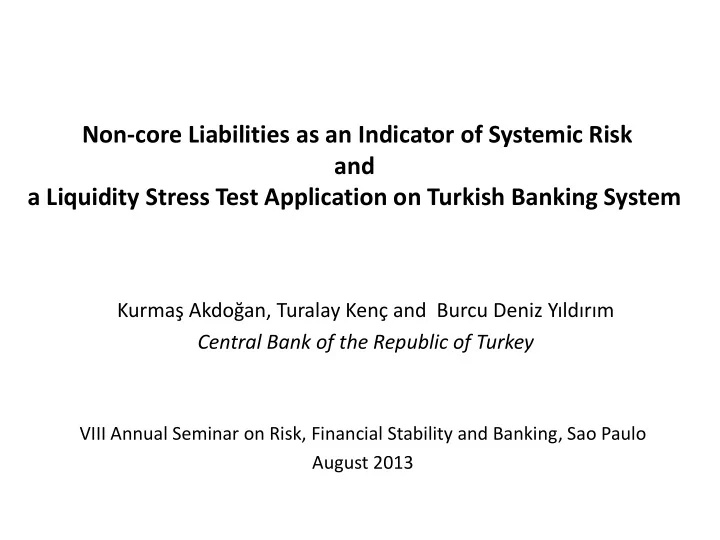

Non-core Liabilities as an Indicator of Systemic Risk and a Liquidity Stress Test Application on Turkish Banking System Kurmaş Akdoğan, Turalay Kenç and Burcu Deniz Yıldırım Central Bank of the Republic of Turkey VIII Annual Seminar on Risk, Financial Stability and Banking, Sao Paulo August 2013
total credits change in total credits / GDP (q-o-q change, 4-quarters moving average, indexed as 2008Q3=1) Note: Advanced countries include Australia, Austria, Belgium, Denmark, Finland, France, Germany, Greece, Ireland, Malta, Singapore, Spain, Switzerland, UK and USA. Emerging markets include Brazil, Chile, Croatia, Czech Republic, Hungary, Mexico, Poland, Russia, South Africa, Thailand and Turkey. Source: Central banks and/or government statistical agencies • capital flows to emerging markets 2
source of funding? • banks play an active role in the amplification of financial shocks (Shin, 2011) • procyclicality – booms and busts – credit growth exceeds deposit growth – alternative sources of funding! • wholesale funding • foreign borrowing • interbank borrowing 3
classification of liabilities • core liabilities (e.g. household deposits) • reliable • relatively cheaper • move with the aggregate wealth of the household • non-core liabilities (e.g. borrowing from other banks) • sensitive to market conditions • relatively more expensive • procyclical • short-term nature 4
core and non-core liabilities Core Liabilities Intermediate Noncore Liabilities Non- financial Corp’s. Households Financial Institutions Demand deposits Demand deposits Demand deposits Short Short-term deposits Short-term deposits Funds from repo transactions Term (<1 month) (<3 months) Short-term payables to banks Medium and long-term deposits Medium-term deposits Medium Medium and long-term payables to (1 month-1 year) Term Medium and long-term banks deposits Long-term deposits Securities issued Long Other borrowings from banks (>1 year) Term 5
non-core liabilities: US non-core liabilities and constituents as a fraction of M2 Source: FED NY and Board of Governors • a tax of 15 b.p. on non-core liabilities is proposed by Obama gov ’t. • this works as a tool for macro-prudential regulation as well! (Shin, 2010) 6
non-core liabilities: Korea non-core liabilities and constituents as a fraction of M2 Source: Bank of Korea 7
non-core liabilities: Turkey non-core liabilities and constituents as a fraction of M2 Source: CBRT 8
Turkey: decomposition of non-core liabilities 9
non-core liabilities and total credit (change, 3-months average, adjusted for the exchange rate, millions of TL) Source: CBRT and BRSA. 10
non-core liabilities and cost of credit left axis : noncore liabilities, change, 3-months average, adj. for the exchange rate, millions of TL right axis: TL business loan rate-TL deposit rate, per cent Source: CBRT 11
liquidity stress test • liquidity and/or solvency • contagion • funding liquidity vs. market liquidity • Basel III – liquidity coverage ratio (LCR) – net stable funding ratio (NSFR) • BRSA – liquidity requirement ratio (LRR) 12
funding liquidity measures • 𝑀𝐷𝑆 = 𝑡𝑢𝑝𝑑𝑙 𝑝𝑔 ℎ𝑗ℎ 𝑟𝑣𝑏𝑚𝑗𝑢𝑧 𝑚𝑗𝑟𝑣𝑗𝑒 𝑏𝑡𝑡𝑓𝑢𝑡 𝑢𝑝𝑢𝑏𝑚 𝑑𝑏𝑡ℎ 𝑜𝑓𝑢 𝑝𝑣𝑢𝑔𝑚𝑝𝑥 (30 𝑒𝑏𝑧𝑡) • NSFR = 𝑏𝑤𝑏𝑗𝑚𝑏𝑐𝑚𝑓 𝑏𝑛𝑝𝑣𝑜𝑢 𝑝𝑔 𝑡𝑢𝑏𝑐𝑚𝑓 𝑔𝑣𝑜𝑒𝑗𝑜 𝑠𝑓𝑟𝑣𝑗𝑠𝑓𝑒 𝑏𝑛𝑝𝑣𝑜𝑢 𝑝𝑔 𝑡𝑢𝑏𝑐𝑚𝑓 𝑔𝑣𝑜𝑒𝑗𝑜 • 𝑀𝑆𝑆 = 𝑡𝑢𝑝𝑑𝑙 𝑏𝑡𝑡𝑓𝑢𝑡+𝑑𝑏𝑡ℎ 𝑗𝑜𝑔𝑚𝑝𝑥𝑡 (30 𝑒𝑏𝑧𝑡) 𝑢𝑝𝑢𝑏𝑚 𝑑𝑏𝑡ℎ 𝑝𝑣𝑢𝑔𝑚𝑝𝑥𝑡 (30 𝑒𝑏𝑧𝑡) 13
simulations • haircut ratios and run-off rates • cash inflows and outflows • BRSA’s liquidity template • RAS algorithm 0 … 𝑓 1𝑘 … 𝑓 1𝑂 ⋮ ⋱ ⋮ ⋱ ⋮ 𝑓 𝑗1 ⋯ 0 ⋯ 𝑓 𝑗𝑂 E = ⋮ ⋱ ⋮ ⋱ ⋮ 𝑓 𝑂1 … 𝑓 𝑂𝑘 ⋯ 0 14
actual exposures 15
a more connected and more concentrated structure Gai et al. (2011) , Nier et al. (2008) 16
complete structure (more connected but less concentrated 17
conclusions • non-core liabilities – a good indicator of systemic risk – procyclical • robust funding conditions for the Turkish banking sector 18
Recommend
More recommend